GSK3β Polyclonal Antibody
- Catalog No.:YT2082
- Applications:IF;WB;IHC;IP;ELISA
- Reactivity:Human;Mouse;Rat;Rabbit
- Target:
- GSK3β
- Fields:
- >>EGFR tyrosine kinase inhibitor resistance;>>ErbB signaling pathway;>>Chemokine signaling pathway;>>Cell cycle;>>mTOR signaling pathway;>>PI3K-Akt signaling pathway;>>Wnt signaling pathway;>>Hedgehog signaling pathway;>>Axon guidance;>>Hippo signaling pathway;>>Focal adhesion;>>Signaling pathways regulating pluripotency of stem cells;>>IL-17 signaling pathway;>>T cell receptor signaling pathway;>>B cell receptor signaling pathway;>>Neurotrophin signaling pathway;>>Dopaminergic synapse;>>Insulin signaling pathway;>>Melanogenesis;>>Prolactin signaling pathway;>>Thyroid hormone signaling pathway;>>Insulin resistance;>>Non-alcoholic fatty liver disease;>>Cushing syndrome;>>Growth hormone synthesis, secretion and action;>>Alcoholic liver disease;>>Alzheimer disease;>>Prion disease;>>Pathways of neurodegeneration - multiple diseases;>>Shigellosis;>>Yersinia infection;>>Hepatitis C;>>Measles;>>Human cytomegalovirus infection;>>Human papillomavirus infection;>>Kaposi sarcoma-associated herpes
- Gene Name:
- GSK3B
- Protein Name:
- Glycogen synthase kinase-3 beta
- Human Gene Id:
- 2932
- Human Swiss Prot No:
- P49841
- Mouse Gene Id:
- 56637
- Mouse Swiss Prot No:
- Q9WV60
- Rat Gene Id:
- 84027
- Rat Swiss Prot No:
- P18266
- Immunogen:
- The antiserum was produced against synthesized peptide derived from human GSK3B. AA range:1-50
- Specificity:
- GSK3β Polyclonal Antibody detects endogenous levels of GSK3β protein.
- Formulation:
- Liquid in PBS containing 50% glycerol, 0.5% BSA and 0.02% sodium azide.
- Source:
- Polyclonal, Rabbit,IgG
- Dilution:
- IF 1:50-200 WB 1:500 - 1:2000. IHC 1:100 - 1:300. Immunoprecipitation: 2-5 ug:mg lysate. ELISA: 1:20000. Not yet tested in other applications.
- Purification:
- The antibody was affinity-purified from rabbit antiserum by affinity-chromatography using epitope-specific immunogen.
- Concentration:
- 1 mg/ml
- Storage Stability:
- -15°C to -25°C/1 year(Do not lower than -25°C)
- Other Name:
- GSK3B;Glycogen synthase kinase-3 beta;GSK-3 beta;Serine/threonine-protein kinase GSK3B
- Observed Band(KD):
- 47kD
- Background:
- The protein encoded by this gene is a serine-threonine kinase, belonging to the glycogen synthase kinase subfamily. It is involved in energy metabolism, neuronal cell development, and body pattern formation. Polymorphisms in this gene have been implicated in modifying risk of Parkinson disease, and studies in mice show that overexpression of this gene may be relevant to the pathogenesis of Alzheimer disease. Alternatively spliced transcript variants encoding different isoforms have been found for this gene.[provided by RefSeq, Sep 2009],
- Function:
- catalytic activity:ATP + [tau protein] = ADP + [tau protein] phosphate.,enzyme regulation:Inhibited when phosphorylated by AKT1.,function:Participates in the Wnt signaling pathway. Implicated in the hormonal control of several regulatory proteins including glycogen synthase, MYB and the transcription factor JUN. Phosphorylates JUN at sites proximal to its DNA-binding domain, thereby reducing its affinity for DNA. Phosphorylates MUC1 in breast cancer cells, and decreases the interaction of MUC1 with CTNNB1/beta-catenin.,PTM:Phosphorylated by AKT1 and ILK1.,similarity:Belongs to the protein kinase superfamily.,similarity:Belongs to the protein kinase superfamily. CMGC Ser/Thr protein kinase family. GSK-3 subfamily.,similarity:Contains 1 protein kinase domain.,subunit:Monomer (By similarity). Interacts with CABYR, MUC1, NIN and PRUNE.,tissue specificity:Expressed in testis, thymus, prostate
- Subcellular Location:
- Cytoplasm . Nucleus . Cell membrane . The phosphorylated form shows localization to cytoplasm and cell membrane (PubMed:20937854). The MEMO1-RHOA-DIAPH1 signaling pathway controls localization of the phosphorylated form to the cell membrane (PubMed:20937854). .
- Expression:
- Expressed in testis, thymus, prostate and ovary and weakly expressed in lung, brain and kidney. Colocalizes with EIF2AK2/PKR and TAU in the Alzheimer disease (AD) brain.
Mammalian elongation factor 4 regulates mitochondrial translation essential for spermatogenesis. NATURE STRUCTURAL & MOLECULAR BIOLOGY 2016 Apr 11 WB Human gastric cancer tissues
Effects of D-Chiro-Inositol on Glucose Metabolism in db/db Mice and the Associated Underlying Mechanisms. Frontiers in Pharmacology Front Pharmacol. 2020 Mar;11:354 IHC Mouse 1:250 liver tissues
PRMT5 promotes epithelial‐mesenchymal transition via EGFR‐β‐catenin axis in pancreatic cancer cells. JOURNAL OF CELLULAR AND MOLECULAR MEDICINE 2019 Dec 18 WB Human PaTu8988 cell, SW1990 cell
PHLDA2 regulates EMT and autophagy in colorectal cancer via the PI3K/AKT signaling pathway. Aging-US Aging-Us. 2020 May 15; 12(9): 7985–8000 WB Mouse 1:1000 HCT-116 cell-Xenograft , SW480 cell-Xenograft HCT-116 cell,SW480 cell
Effects of Agriophyllum squarrosum extracts on glucose metabolism in KKAy mice and the associated underlying mechanisms. JOURNAL OF ETHNOPHARMACOLOGY J Ethnopharmacol. 2019 Sep;241:112009 WB Mouse 1:500 liver
Ponicidin inhibits pro-inflammatory cytokine TNF-α-induced epithelial–mesenchymal transition and metastasis of colorectal cancer cells via suppressing the AKT/GSK-3β/Snail pathway. INFLAMMOPHARMACOLOGY Inflammopharmacology. 2019 Jun;27(3):627-638 WB Human 1:1500 HCT116 cell
Attenuation of the degenerative effects of endothelin-1 on cartilaginous end plate cells by the endothelin receptor antagonist BQ-123 via the Wnt/β-catenin signaling pathway. Spine Journal Spine J. 2018 Sep;18:1669 WB Rabbit cartilaginous end plate cells (CECs)
Gene silencing of USP1 by lentivirus effectively inhibits proliferation and invasion of human osteosarcoma cells. INTERNATIONAL JOURNAL OF ONCOLOGY 2016 Dec 01 WB Human U2OS cell
Gastrointestinal Factor GDDR Attenuates Epithelial–Mesenchymal Transition in Gastric Cancer via Inhibiting AKT Signal. DIGESTIVE DISEASES AND SCIENCES Digest Dis Sci. 2016 Jul;61(7):1941-1949 WB Human gastric cancer tissues SGC7901 cell
METTL3 attenuates proliferative vitreoretinopathy and epithelial‐mesenchymal transition of retinal pigment epithelial cells via wnt/β‐catenin pathway. JOURNAL OF CELLULAR AND MOLECULAR MEDICINE J Cell Mol Med. 2021 May;25(9):4220-4234 WB Human 1 : 1000 ARPE-19 cell
Long noncoding RNA MALAT1 knockdown reverses chemoresistance to temozolomide via promoting microRNA‐101 in glioblastoma. Cancer Medicine Cancer Med-Us. 2018 Apr;7(4):1404-1415 WB Human 1:1000 U251 cell, U251/TMZ cell
Dickkopf Wnt signaling pathway inhibitor 1 regulates the differentiation of mouse embryonic stem cells in vitro and in vivo. Molecular Medicine Reports Mol Med Rep. 2016 Jan;13(1):720-730 WB Mouse ESCs
Environmental Enrichment Improves Spatial Learning and Memory in Vascular Dementia Rats with Activation of Wnt/β-Catenin Signal Pathway. MEDICAL SCIENCE MONITOR Med Sci Monitor. 2017; 23: 207–215 WB Rat 1: 1000 hippocampus
Cai, Tao, Yu Liu, and Jie Xiao. "Long noncoding RNA MALAT 1 knockdown reverses chemoresistance to temozolomide via promoting micro RNA‐101 in glioblastoma." Cancer medicine 7.4 (2018): 1404-1415.
Ou, Liping, et al. "Dickkopf Wnt signaling pathway inhibitor 1 regulates the differentiation of mouse embryonic stem cells in vitro and in vivo." Molecular medicine reports 13.1 (2016): 720-730.
Lu, Jian, et al. "Role of LKB1 in migration and invasion of Cr (VI)-transformed human bronchial epithelial Beas-2B cells." Anti-cancer drugs 29.7 (2018): 660-673.
PHLDA2 regulates EMT and autophagy in colorectal cancer via the PI3K/AKT signaling pathway. Aging-US Aging-Us. 2020 May 15; 12(9): 7985–8000 WB Mouse 1:1000 HCT-116 cell-Xenograft , SW480 cell-Xenograft HCT-116 cell,SW480 cell
P25/CDK5-mediated Tau Hyperphosphorylation in Both Ipsilateral and Contralateral Cerebra Contributes to Cognitive Deficits in Post-stroke Mice Current Medical Science Yu Jing WB Mouse 1:1000 Cortex,hippocampus
Dexmedetomidine facilitates autophagic flux to promote liver regeneration by suppressing GSK3β activity in mouse partial hepatectomy BIOMEDICINE & PHARMACOTHERAPY Xueya Yao WB Mouse 1:1000 liver tissue primary mouse hepatocytes,AML-12 cell
Oligosaccharides of Ophiopogon japonicus ameliorate insulin resistance and glucolipid metabolism in HFD/STZ-induced T2DM rats and IR-HepG2 cells via activation of the IRS-1/PI3K/AKT/GSK-3β pathway Journal of Functional Foods Baoting Chen WB Rat,Human liver tissue HepG2 cell
Kaempferol inhibited invasion and metastasis of gastric cancer cells by targeting AKT/GSK3β pathway based on network pharmacology and molecular docking JOURNAL OF ASIAN NATURAL PRODUCTS RESEARCH Xia-Qing Gao WB Human 1:1000 HGC27 cell,MKN45 cell
- June 19-2018
- WESTERN IMMUNOBLOTTING PROTOCOL
- June 19-2018
- IMMUNOHISTOCHEMISTRY-PARAFFIN PROTOCOL
- June 19-2018
- IMMUNOFLUORESCENCE PROTOCOL
- September 08-2020
- FLOW-CYTOMEYRT-PROTOCOL
- May 20-2022
- Cell-Based ELISA│解您多样本WB检测之困扰
- July 13-2018
- CELL-BASED-ELISA-PROTOCOL-FOR-ACETYL-PROTEIN
- July 13-2018
- CELL-BASED-ELISA-PROTOCOL-FOR-PHOSPHO-PROTEIN
- July 13-2018
- Antibody-FAQs
- Products Images
.jpg)
- Ma, Xinqi, et al. "METTL3 attenuates proliferative vitreoretinopathy and epithelial‐mesenchymal transition of retinal pigment epithelial cells via wnt/β‐catenin pathway." Journal of Cellular and Molecular Medicine 25.9 (2021): 4220-4234.
.jpg)
- Ge, Lu, et al. "PRMT5 promotes epithelial‐mesenchymal transition via EGFR‐β‐catenin axis in pancreatic cancer cells." Journal of cellular and molecular medicine 24.2 (2020): 1969-1979.
.jpg)
- Ma, Zhan, Shuping Lou, and Zheng Jiang. "PHLDA2 regulates EMT and autophagy in colorectal cancer via the PI3K/AKT signaling pathway." Aging (Albany NY) 12.9 (2020): 7985.
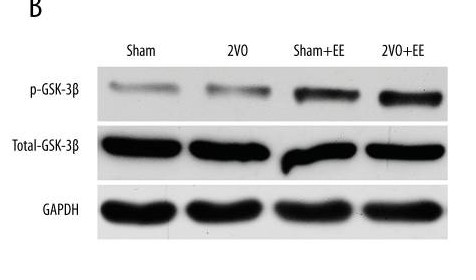
- Jin, Xinhao, et al. "Environmental Enrichment Improves Spatial Learning and Memory in Vascular Dementia Rats with Activation of Wnt/β-Catenin Signal Pathway." Medical science monitor: international medical journal of experimental and clinical research 23 (2017): 207.
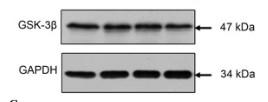
- Ou, Liping, et al. "Dickkopf Wnt signaling pathway inhibitor 1 regulates the differentiation of mouse embryonic stem cells in vitro and in vivo." Molecular medicine reports 13.1 (2016): 720-730.
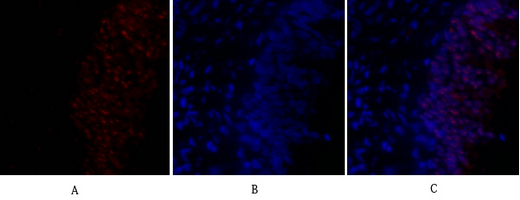
- Immunofluorescence analysis of rat-lung tissue. 1,GSK3β Polyclonal Antibody(red) was diluted at 1:200(4°C,overnight). 2, Cy3 labled Secondary antibody was diluted at 1:300(room temperature, 50min).3, Picture B: DAPI(blue) 10min. Picture A:Target. Picture B: DAPI. Picture C: merge of A+B
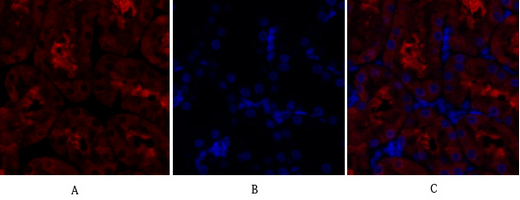
- Immunofluorescence analysis of rat-kidney tissue. 1,GSK3β Polyclonal Antibody(red) was diluted at 1:200(4°C,overnight). 2, Cy3 labled Secondary antibody was diluted at 1:300(room temperature, 50min).3, Picture B: DAPI(blue) 10min. Picture A:Target. Picture B: DAPI. Picture C: merge of A+B
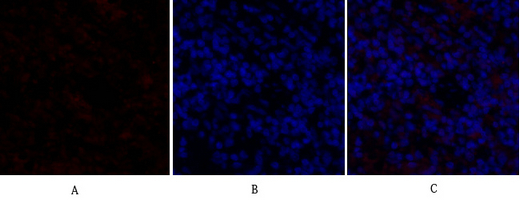
- Immunofluorescence analysis of rat-spleen tissue. 1,GSK3β Polyclonal Antibody(red) was diluted at 1:200(4°C,overnight). 2, Cy3 labled Secondary antibody was diluted at 1:300(room temperature, 50min).3, Picture B: DAPI(blue) 10min. Picture A:Target. Picture B: DAPI. Picture C: merge of A+B
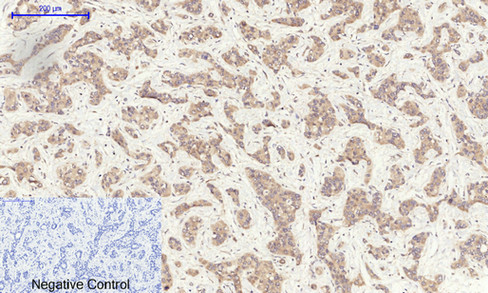
- Immunohistochemical analysis of paraffin-embedded Human-liver-cancer tissue. 1,GSK3β Polyclonal Antibody was diluted at 1:200(4°C,overnight). 2, Sodium citrate pH 6.0 was used for antibody retrieval(>98°C,20min). 3,Secondary antibody was diluted at 1:200(room tempeRature, 30min). Negative control was used by secondary antibody only.
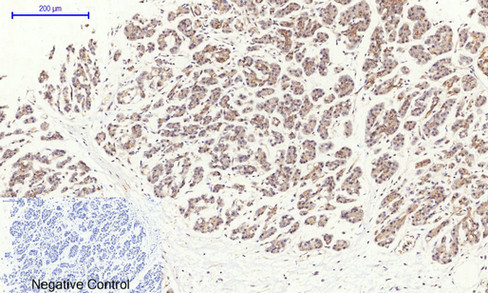
- Immunohistochemical analysis of paraffin-embedded Human-stomach-cancer tissue. 1,GSK3β Polyclonal Antibody was diluted at 1:200(4°C,overnight). 2, Sodium citrate pH 6.0 was used for antibody retrieval(>98°C,20min). 3,Secondary antibody was diluted at 1:200(room tempeRature, 30min). Negative control was used by secondary antibody only.
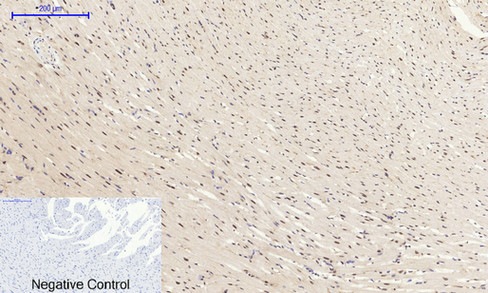
- Immunohistochemical analysis of paraffin-embedded Rat-heart tissue. 1,GSK3β Polyclonal Antibody was diluted at 1:200(4°C,overnight). 2, Sodium citrate pH 6.0 was used for antibody retrieval(>98°C,20min). 3,Secondary antibody was diluted at 1:200(room tempeRature, 30min). Negative control was used by secondary antibody only.
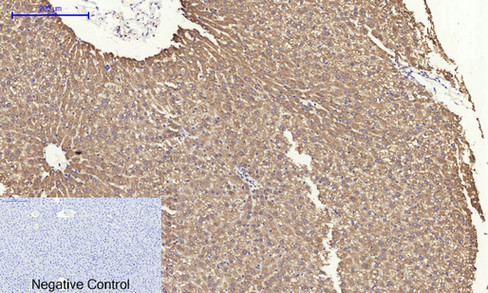
- Immunohistochemical analysis of paraffin-embedded Rat-liver tissue. 1,GSK3β Polyclonal Antibody was diluted at 1:200(4°C,overnight). 2, Sodium citrate pH 6.0 was used for antibody retrieval(>98°C,20min). 3,Secondary antibody was diluted at 1:200(room tempeRature, 30min). Negative control was used by secondary antibody only.
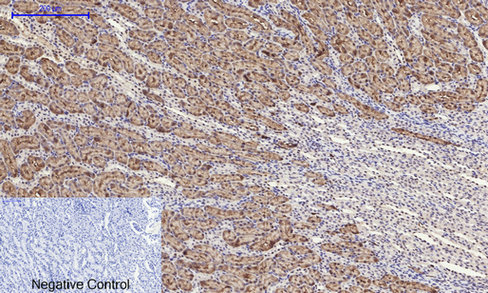
- Immunohistochemical analysis of paraffin-embedded Rat-kidney tissue. 1,GSK3β Polyclonal Antibody was diluted at 1:200(4°C,overnight). 2, Sodium citrate pH 6.0 was used for antibody retrieval(>98°C,20min). 3,Secondary antibody was diluted at 1:200(room tempeRature, 30min). Negative control was used by secondary antibody only.
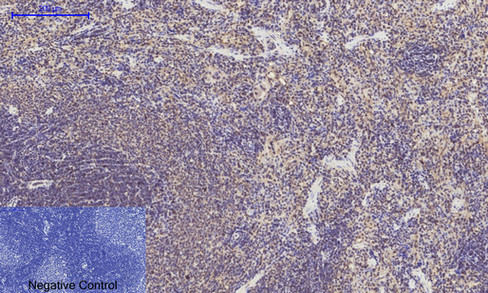
- Immunohistochemical analysis of paraffin-embedded Rat-spleen tissue. 1,GSK3β Polyclonal Antibody was diluted at 1:200(4°C,overnight). 2, Sodium citrate pH 6.0 was used for antibody retrieval(>98°C,20min). 3,Secondary antibody was diluted at 1:200(room tempeRature, 30min). Negative control was used by secondary antibody only.
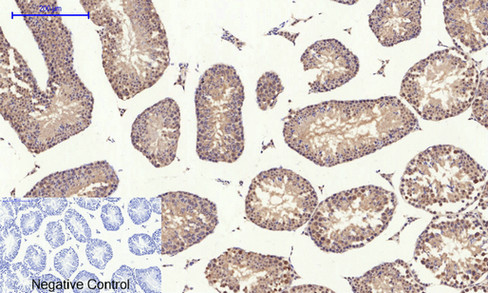
- Immunohistochemical analysis of paraffin-embedded Mouse-testis tissue. 1,GSK3β Polyclonal Antibody was diluted at 1:200(4°C,overnight). 2, Sodium citrate pH 6.0 was used for antibody retrieval(>98°C,20min). 3,Secondary antibody was diluted at 1:200(room tempeRature, 30min). Negative control was used by secondary antibody only.
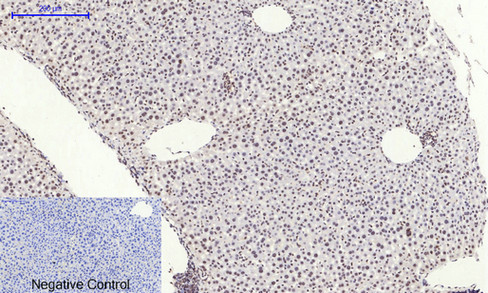
- Immunohistochemical analysis of paraffin-embedded Mouse-liver tissue. 1,GSK3β Polyclonal Antibody was diluted at 1:200(4°C,overnight). 2, Sodium citrate pH 6.0 was used for antibody retrieval(>98°C,20min). 3,Secondary antibody was diluted at 1:200(room tempeRature, 30min). Negative control was used by secondary antibody only.
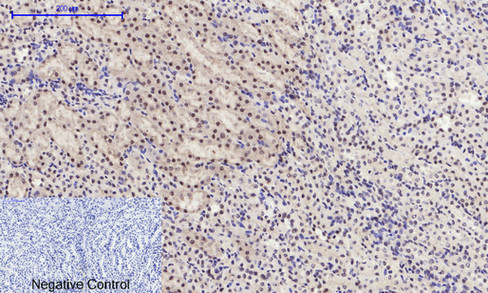
- Immunohistochemical analysis of paraffin-embedded Mouse-kidney tissue. 1,GSK3β Polyclonal Antibody was diluted at 1:200(4°C,overnight). 2, Sodium citrate pH 6.0 was used for antibody retrieval(>98°C,20min). 3,Secondary antibody was diluted at 1:200(room tempeRature, 30min). Negative control was used by secondary antibody only.
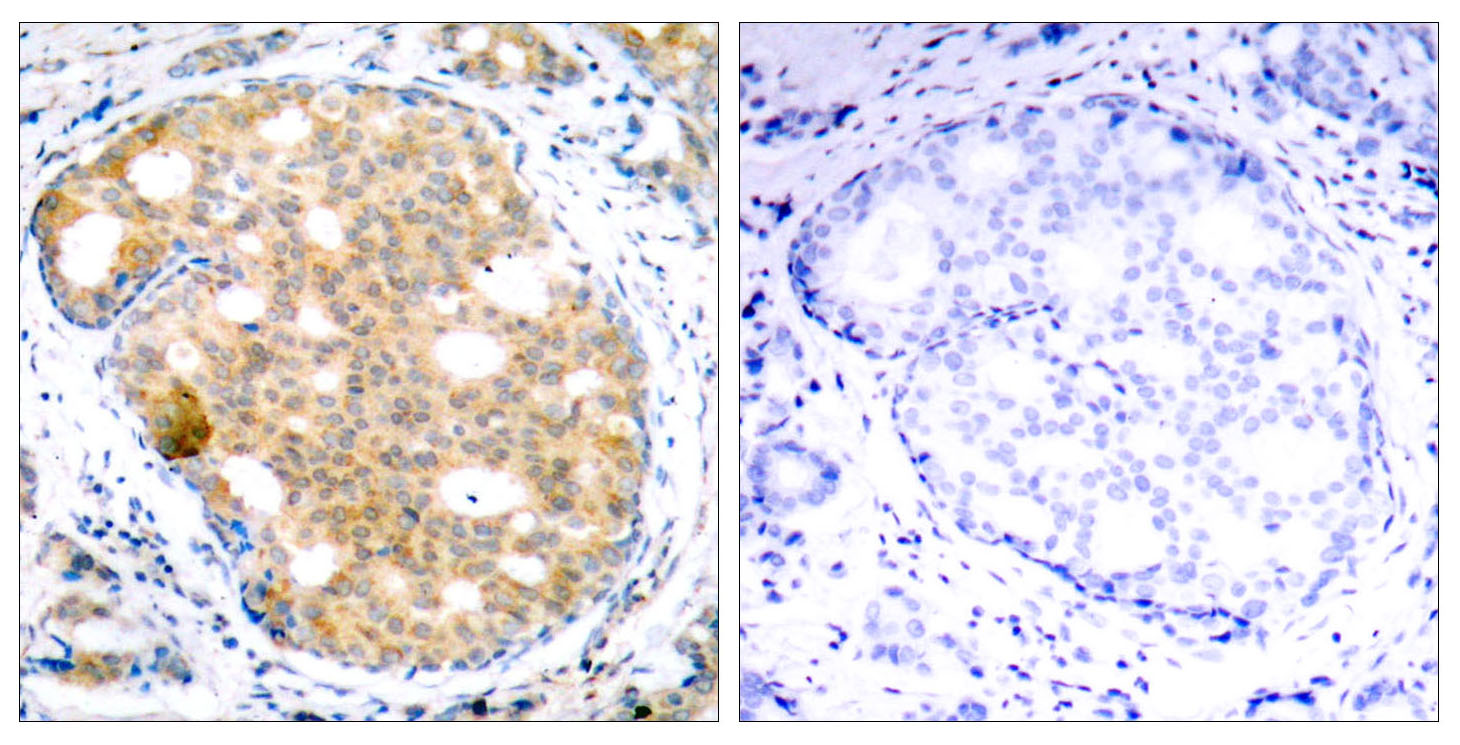
- Immunohistochemistry analysis of paraffin-embedded human breast carcinoma, using GSK3 beta Antibody. The picture on the right is blocked with the synthesized peptide.
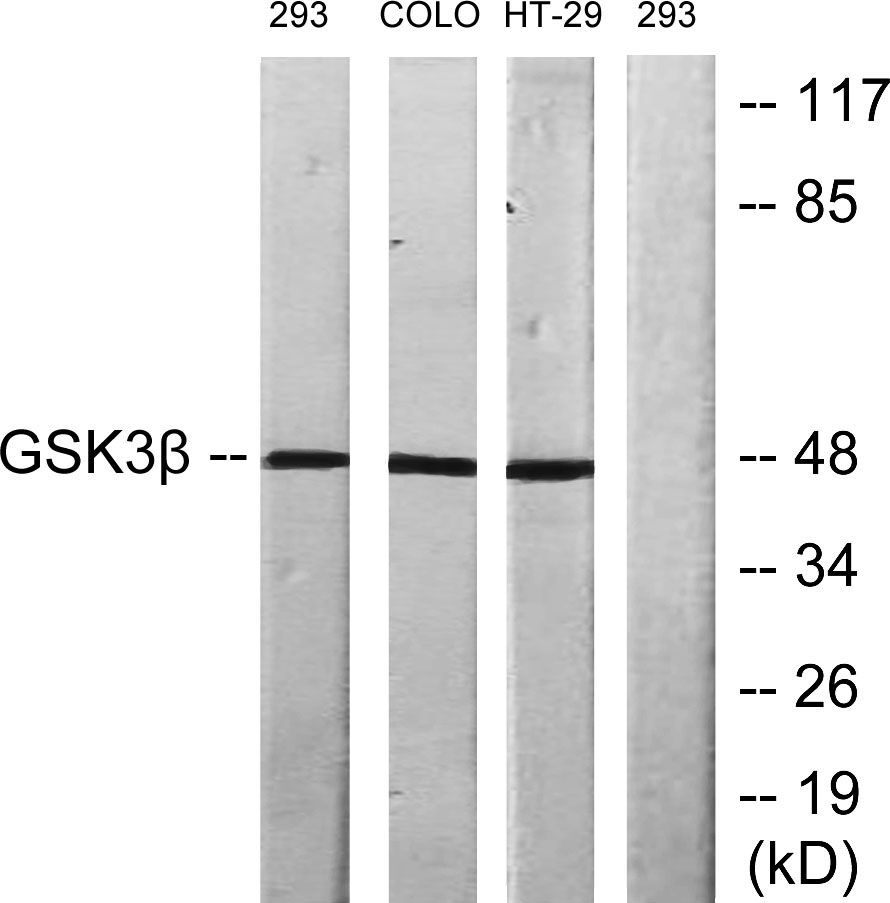
- Western blot analysis of lysates from 293, COLO205, and HT29 cells, using GSK3 beta Antibody. The lane on the right is blocked with the synthesized peptide.
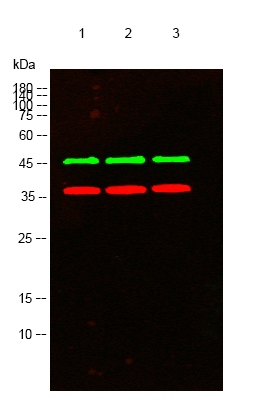
- Western blot analysis of lysates from 1) 3T3, 2) HT29, 3) 293 cells, (Green) primary antibody was diluted at 1:1000, 4°over night, secondary antibody(cat:RS23920)was diluted at 1:10000, 37° 1hour. (Red) GAPDH Monoclonal Antibody(2B8) (cat:YM3029) antibody was diluted at 1:5000 as loading control, 4° over night,secondary antibody(cat:RS23710)was diluted at 1:10000, 37° 1hour.
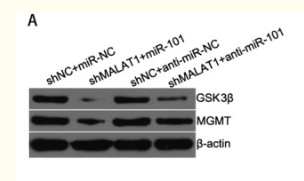
- Cai, Tao, Yu Liu, and Jie Xiao. "Long noncoding RNA MALAT 1 knockdown reverses chemoresistance to temozolomide via promoting micro RNA‐101 in glioblastoma." Cancer medicine 7.4 (2018): 1404-1415.



